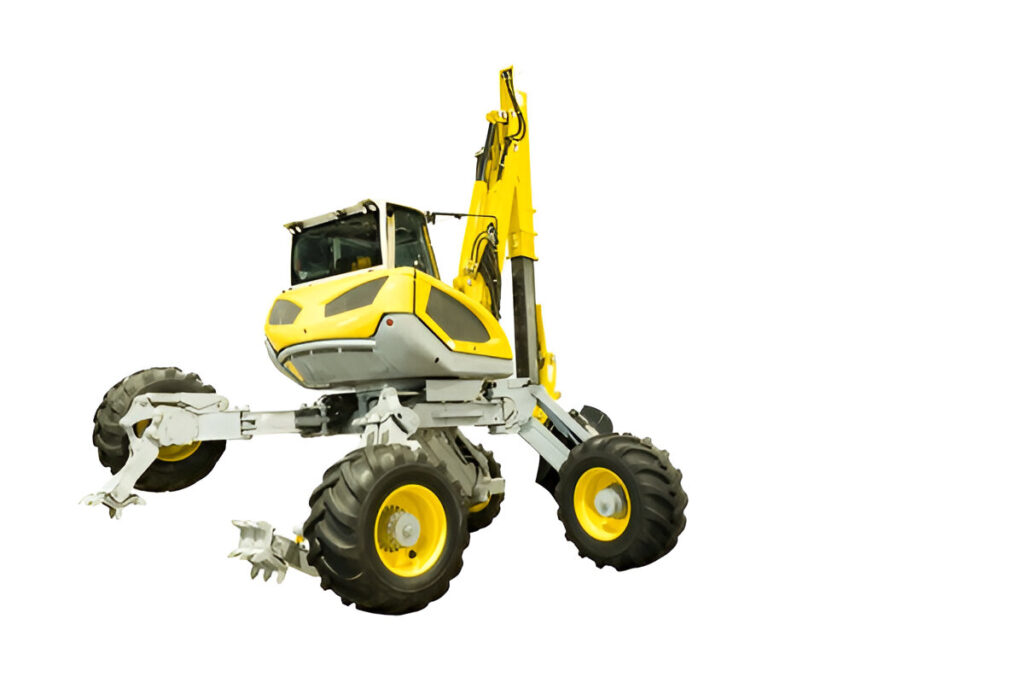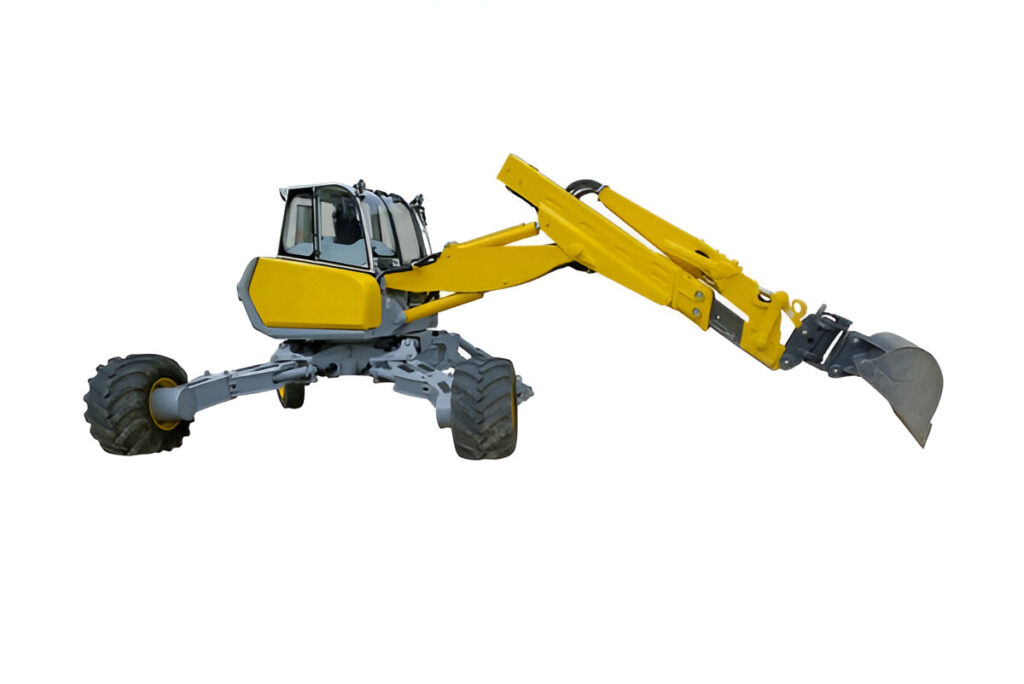
What are Spider Excavators?
The Spider Excavator, also called a Crawler Excavator or Spider Crane, is a game-changer in construction machinery. Known for its exceptional maneuverability and adaptability, it is designed to tackle tough terrains and confined spaces with ease. This article explores the key features, uses, advantages, and considerations of Spider Excavators .
Components of Spider Excavators
The spider excavator is specialized construction machinery designed for versatile operation in challenging terrains. Its unique configuration comprises the following key components:
- Articulated Legs: The spider excavator features a plurality of articulated legs extending outwardly from a central hub. These legs are equipped with positioning engagement members that can be adjusted along the length of each leg, thereby accommodating various tire and rim sizes. Moreover, this adaptability allows the excavator to maintain stability and traction on uneven or steep surfaces.
- Central Hub: The central hub serves as the connection point for the articulated legs and the hydraulic piston. Notably, its hexagonal shape in the described design allows for optimal positioning and attachment of the legs at desirable angles. As a result, this ensures structural integrity and efficient force distribution.
- Hydraulic Piston: The hydraulic piston is a crucial component that provides the necessary power and actuation for the spider excavator’s movements. Specifically, it is connected to the central hub and enables the extension and retraction of the legs. Consequently, this facilitates improved maneuverability and seamless terrain adaptation.
- Positioning and Alignment Systems: The spider excavator incorporates positioning rods and alignment mechanisms to ensure proper orientation and placement of the excavator during operation. These systems allow for precise positioning, particularly when working with smaller components or in confined spaces.

Types of Spider Excavators
Compact Spider Excavators
These are the smallest and most maneuverable spider excavators, specifically designed for confined spaces and indoor operations. Typically, they have a working weight under 4 tons and a width of around 3 feet, thereby allowing access through narrow doorways and corridors. As a result, they are ideal for various applications, including:
- Residential remodeling and basement excavation
- Utility work like pipe laying and repair in tight urban areas
- Landscaping and tree removal in limited access areas
Mini Spider Excavators
Slightly larger than compact models, mini spider excavators weigh 4-6 tons and offer increased digging depth and reach. Their compact size and rubber tracks minimize ground disturbance, making them suitable for:
- Sensitive environmental areas like wetlands and nature preserves
- Landscaping and grading on established properties without damaging lawns
- Indoor demolition and renovation projects in commercial buildings
Standard Spider Excavators
These conventional spider excavators weigh 6-10 tons and provide greater digging force and lift capacity compared to smaller models. Their versatility makes them useful for:
- General construction and earthmoving on confined jobsites
- Demolition and structural dismantling in urban areas
- Bridge and infrastructure repair in areas with limited access
Heavy-Duty Spider Excavators
The largest and most powerful spider excavators can weigh over 10 tons and feature long-reach booms for increased versatility. Their robust design allows them to handle demanding applications like:
- Quarry and mining operations in remote or restricted areas
- Heavy industrial demolition and site preparation
- Emergency response and disaster relief in unstable or hazardous environments
Recent advancements in spider excavator technology include hybrid electric/diesel power systems for improved fuel efficiency and reduced emissions, as well as enhanced telematics and remote monitoring capabilities for better fleet management and utilization tracking.
Advantages of Spider Excavators Over Traditional Excavators
Spider excavators offer several advantages over traditional excavators, particularly in challenging environments:
- Compact Size and Maneuverability: Their compact design and ability to turn within a small radius allow them to operate in confined spaces and navigate through narrow passages, making them ideal for urban and indoor projects.
- Low Ground Pressure: The weight distribution and tracked undercarriage of spider excavators result in low ground pressure, minimizing soil compaction and damage to surfaces like lawns, gardens, or finished floors.
- Versatility: Spider excavators can be equipped with a wide range of attachments, such as buckets, breakers, grapples, and augers, enabling them to perform various tasks beyond excavation.
- Accessibility: Their ability to traverse rough terrain, climb stairs, and navigate through tight spaces makes them suitable for projects in remote or difficult-to-access areas.
- Reduced Environmental Impact: Many spider excavators are powered by eco-friendly engines or electric motors, resulting in lower emissions and noise levels, making them suitable for use in environmentally sensitive areas or indoor projects.

Challenges and Limitations of Spider Excavators
- Operational Efficiency and Productivity: While spider excavators offer versatility in accessing confined spaces, their smaller size and reduced digging forces may limit their productivity compared to conventional excavators, especially in heavy-duty applications.
- Maintenance and Repair Complexity: The intricate walking mechanism and hydraulic systems of spider excavators can increase maintenance complexity and downtime, potentially leading to higher operational costs.
- Limited Reach and Digging Depth: Spider excavators typically have a shorter boom and arm length compared to conventional excavators, restricting their reach and digging depth capabilities, which can be a limitation in certain applications.
Applications of Spider Excavators
Their unique design and capabilities make them suitable for various applications, including:
- Construction and Demolition: Spider excavators excel in construction and demolition projects where space is limited or access is restricted. Their compact size and maneuverability allow them to navigate through narrow passages, making them ideal for interior demolition, basement excavation, and renovation work in residential or commercial buildings.
- Landscaping and Gardening: The compact size and low ground pressure of spider excavators minimize soil compaction and damage to lawns or gardens. They are commonly used for landscaping tasks such as digging trenches for irrigation systems, grading, and site preparation. Their versatility also allows them to be equipped with various attachments like augers, grapples, and tilting buckets for specialized tasks.
- Utility and Infrastructure Maintenance: Spider excavators are invaluable in maintaining and repairing underground utilities like water, gas, and sewer lines. Thanks to their ability to work in tight spaces and navigate through urban environments, they are particularly suitable for tasks such as pipe laying, cable installation, and repair work in congested areas.
- Agricultural and Forestry Applications: In agricultural settings, spider excavators can be utilized for tasks such as digging drainage ditches, clearing land, and maintaining irrigation systems. Furthermore, in forestry, they can assist with trail maintenance, selective logging, and clearing debris after storms or natural disasters. Additionally, their compact size enables them to maneuver through dense vegetation and rough terrain with ease.
- Emergency Response and Rescue Operations: The versatility and maneuverability of spider excavators also make them highly effective in emergency response and rescue operations. For instance, they can be deployed to clear debris, create access routes, and assist in search and rescue efforts in areas impacted by natural disasters or accidents.
Application Cases
| Menzi Muck M545 | Enhanced stability and maneuverability in confined spaces due to its adjustable legs and low ground pressure. | Urban construction sites, indoor demolition, and utility work in basements and tunnels. |
| Kaiser S12 Allroad | High versatility with various attachments, suitable for environmental remediation tasks. | Hazardous waste cleanup, soil remediation, and wetland restoration. |
| Euromach R145 | Lightweight design with low ground pressure, ideal for landscaping and gardening without damaging surfaces. | Digging trenches for irrigation, grading soil, and removing trees in residential areas. |
Latest Technical Innovations in Spider Excavators
Electrification and Hybridization
Spider excavators are transitioning towards electrified and hybrid powertrains to reduce emissions and improve efficiency. Key innovations include:
- Lithium-ion battery packs integrated into the undercarriage for electric operation
- Hybrid systems combining diesel engines with electric motors for swing operations
- Advanced energy management systems optimizing power distribution
Intelligent Control Systems
Advanced control systems leverage sensors, GPS, and machine learning algorithms to enhance operability and productivity:
- Semi-autonomous functions like automatic obstacle avoidance and self-leveling
- Telematics for remote monitoring of performance data and predictive maintenance
- Gesture and voice control interfaces for improved operator ergonomics
Lightweight and High-Strength Materials
Adoption of advanced lightweight materials reduces weight and improves maneuverability:
- Carbon fiber reinforced polymer (CFRP) components in the boom and outriggers
- High-strength aluminum alloys in the undercarriage for weight savings
- Optimized structural designs through topology optimization and generative design
Compact and Modular Designs
Innovations focused on increasing accessibility and transportability in confined spaces:
- Compact designs with reduced tail-swing and minimal footprint
- Modular and detachable components for ease of transportation
- Articulated steering systems enabling tight turning radiuses
To get detailed scientific explanations of Spider Excavator, try Patsnap Eureka.

